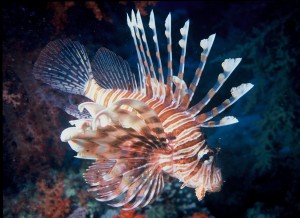BIOS Highlights Lionfish Threat
When more than 1,100 Bermudian primary school children took part in the Bermuda Institute of Ocean Sciences [BIOS] Explorer programme at the East End research facility in the spring of 2011, two colourful lionfish, Simba and Nala, were among the stars of the show.
But the lionfish were being displayed to teach the youngsters an important lesson about Bermuda’s delicate marine ecosystem.
“Simba and Nala, and volunteers from the Ocean Support Foundation, were on hand to explain the perils of allowing this invasive animal to gain a foothold in Bermuda: while they may look spectacular with their spots, stripes and frills, these lionfish are voracious predators against which Bermuda’s reef fish have no defense,” said BIOS Outreach Programme coordinator Dean Lea. “Fortunately they are delicious — so let’s eat ‘em to beat ‘em”
BIOS Explorer Programme Lionfish Video
Efforts to snatch victory from the jaws of the lionfish by enlisting restaurants to add the fish to their menus continue to gain momentum both locally and in the US thanks to the “Eat Them To Beat Them” initiative first launched on the island by the Bermuda Aquarium, Museum & Zoo’s Chris Flook.
Mr. Flook — who heads Bermuda’s Lionfish Project aimed at reducing the numbers of the invasive species in local waters — has lectured internationally on how restaurants could help reduce the scavenger’s numbers.
The growth of lionfish numbers in the Atlantic and Caribbean over the last decade continue to raise major concerns among marine conservationists in Bermuda, Florida and the West Indies.
Native to the Indo-Pacific ocean and the Red Sea, lionfish have no known predators in the Atlantic.
“It’s a perfect invader. Not having evolved in this ocean it has many advantages that allow it to flourish,” said Laddie Akins, director of special operations at Florida’s Reef Environmental Education Foundation.
REEF is a charity group of civic-minded divers perhaps best known for their ongoing fish surveys.
Bermuda Triangle Diving Video Of Lionfish Cull On Bermuda’s Reefs
Read More About
Category: All, Environment



Great Article..
I have noted that there is NO MENTIONED found anywhere online, that suggests the Sargasso Sea is a major juvenile nursery for lionfish!!..
Now because of the sudden explosion of lionfish in the Caribbean, it sparked my curiosity to find out WHERE and HOW, this had happened overnight around Montserrat, and adjacent islands e.g.. Statia; Tortola BVI; St. Kitts & Nevis; Antigua & Barbuda and Guadeloupe, and knowing also that the Gulf Stream flows towards the Bahamas/Florida Coast, at an average of between 3 to 5 miles per hour, started my research, only to now find that they are now being found on the Central & South American Coasts; Gulf of Mexico; Central African Coast, Azores; Canary Islands and the Cape Verde Islands, then looking at a map of the Sargasso Sea and it’s many surrounding currents, have hypothesised that the Sargasso Sea is a gigantic nursery grounds for lionfish and what we are seeing in the Caribbean is JUST A SMALL FRACTION that have hitch hiked on sargasso weed rafts, which have broken off by storms/heavy seas, and have been transported thru the Caribbean Islands and elsewhere, causing this over night explosion around the islands, and sadly I foresee the devastation not only to our juvenile fish stocks, they will ultimately cause the demise of our coral reefs too, and on top of that detrimental event, they will also be the demise of our pelagic species also, as pelagics’ spawn on/in the Sargasso weeds, and their young inhabit the Sargasso sea, as safe nursery grounds and hatching area for most of our flying fishes; tuna’s; mahi mahi; American & European eels’; turtles; sword fish, etc. so we will lose our commercial fishing industry too!..
It would be great if the Bermuda Institute of Ocean Services, could do a research trip into the Sargasso Sea to investigate this Hypothesise..
I can be contacted at safe500@hotmail.com
Thank You,
Capt. John